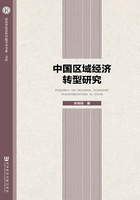
Foreword
With the rapid development of economic society and growing pressure of resources environment, the traditional mode of regional economic development is faced with severe challenges, the transformation of regional economy has become inevitable. Research on regional economic transformation starting from the research perspective of the stage of regional economic development, is the embodiment to follow the law of regional economic development. This helps to grasp the development stages of regional economy and the key problems accurately, and analyze the various problems in transformation better. However, current research in this area is still relatively scarce. This paper clarified the logic relationship between the stages of regional economic development and the transformation of regional economies, decided to research the transformation of regional economies in perspective of the stages of regional economic development, focusing on theoretical framework and empirical test.
Regional economic development consists of four stages: early growth, growth, maturity and late maturity. In early growth, regional economic development tends to be backward. In maturity and late maturity, expansion and depression may happen. So, the backward region, the expansive region and the depressed region are corresponding to regions which tend to backward, expansive and flat. These three types of regions are not only based on the stages of regional economic development and regional feature recognition, but also the premise for the transformation of regional economies.
The stages of regional economic development and regional types determine the initial conditions for the transformation of regional economies. And the initial conditions affect the choice of the mode for the transformation of regional economies, including dynamic mechanism, target and content of transformation, as well as the performance evaluation of transformation. These are the main contents of the framework for the transformation of regional economies. So the stages of regional economic development determine and affect all aspects about the transformation of regional economies, which is the important logical relationship of this paper.
The types of backward region, depressed region and expansive region determine three modes of regional economic transformation. They are the mode of backward region economic transformation, the mode of depressed region economic transformation, and the mode of expansive region economic transformation. The key problems of backward regions are poverty and backwardness, their overall goals of economic transformation are to modernize. The key problems of depressed regions are industrial depression aging and technological backwardness, their overall goals of economic transformation are to restore vitality. The key problems of expansive regions are industrial expansion and overpopulated, their overall goals of economic transformation are to keep vitality forever. About the mode of economic growth, spatial structure adjustment, the optimization of the industrial structure, the improvement of regional welfare, these regions have various main lines. They are the transformation from agricultural society to industrial society, reviving former glory and the renewal.
The performance evaluation of regional economic transformation is an important part of regional economic transformation, which can fully analyzes the effect of the transformation region under study. Currently the performance evaluation of regional economic transformation is according to TFP, target and content of transformation. Considerating of data availability and time nodes, the paper selected the non-parametric DEA-Malmquist index method for estimating TFP and the content of transformation which based on the stage of regional economic development.
In accordance with theidentification methods of regional economic development and problem region, this paper confirms the initial conditions of regional economic transformation in China, broadly in line with the actual discovery. After the performance evaluation of TFP and the content of transformation, found that Chinese backward regions and depressed regions achieved certain results, but the expansive regions have little effect. To compensate for defects in the selected area larger scale, this paper select Baise, Fuxin, and Beijing as the typical of regional economic transformation for backward regions, depressed regions and expansive regions. It gets a similar conclusion.
The transformation of regional economy in America provides experiences for China. The key of regional economic transformation in China lies in accurate positioning, reasonable choice of paths on transformation and timely adjustment, strengthening regional cooperation, promoting reform, improving the performance evaluation mechanism and stricting environmental regulations to create favorable environment for the transformation of regional economy. In terms of the regional types, the focuses of economic transformation are different.
Research idea is to build a theoretical framework of regional economic transformation based on the research perspective of the stage of regional economic development, and make empirical analysis, propose suggestions for regional economic transformation in China. It ran as follows: The first part of this paper is to build a theoretical framework, including Chapter 2 and Chapter 3. Chapter 2 is mainly to clarify the relationship between the stage of regional economic development and the transformation of regional economies, elaborate the theoretical basis. Chapter 3 is to recognize the initial conditions of regional economic transformation by recognizing the development stages of regional economy and the type of problem region, and make the mode selection for transformation(including dynamic mechanism, goal setted and main content designed), and evaluate the performance. These are the contents of regional economic transformation. The second part is the empirical analysis, including Chapter 4 and Chapter 5. Chapter 4 is an overall analysis of China's regional economic transformation. Chapter 5 narrows the research object, select stypical regions for empirical investigation. The third part is the suggestions, including Chapter 6 and Chapter 7. Chapter 6 describes the experiences of regional economic transformation in America, to provide references for regional economic transformation in China. Chapter 7 gives some suggestions for the transformation of regional economies.